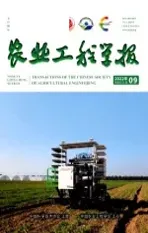海水源热泵对海参育苗废水热能回收的工程应用
2017-06-27李秀辰张殿光张国琛
李秀辰,邓 伟,张殿光,母 刚,张国琛,陈 帅,车 全
海水源热泵对海参育苗废水热能回收的工程应用
李秀辰1,邓 伟1,张殿光1,母 刚1,张国琛1,陈 帅1,车 全2
(1. 大连海洋大学辽宁省渔业装备工程技术研究中心,大连116023; 2. 大连鑫玉龙海洋珍品有限公司,大连 116222)
该文针对水产生物工厂化育苗水体升温技术需求,开展了利用育苗废水作热源为育苗水体升温的海水源热泵集成技术应用示范,探讨了集成系统对海参育苗水体升温和废水热能的回收效果。结果表明,进入Ⅰ级换热器的育苗废水和新鲜海水温度分别为10.3~14.9 ℃和−1.9~4.9 ℃时,新鲜海水出水温度提升4.6~5.8 ℃,废水热能最大回收率达到59.2%;海水源热泵的废水热源温度和流量一定时,新鲜海水的温升幅度随其入流流量和温度升高而降低,入流温度分别为7.3和10.3 ℃的新鲜海水,流量不超过15和20 m3/h时,出水温度均保持在15 ℃以上,满足海参育苗水温要求。热泵对废水热能的最大回收率为40.7%,COP(coefficient of performance)在5.03以上;集成升温系统比传统锅炉升温综合节能37.6%以上,减排二氧化碳约2 200 t/a,当年内可收回设备投资费用。
废水;加热;温度;海参;水体升温;海水源热泵;热能回收
0 引 言
随着中国水产养殖产业的发展,水产苗种市场需求不断增加,苗种培育已成为水产养殖产业的重要组成部分。2015年中国海水苗种产量达78.4亿尾[1],仅辽宁省大连市水产苗种场已达1 000余家,育苗水体超过300多万m2[2]。然而,因受气候条件制约,中国北方水产育苗生产企业每年有5~6个月,需要将−2~5 ℃的水体升温至15~23 ℃[3]。目前主要采用燃煤(油、气)锅炉或电加热进行水体升温。因育苗用水量大,致使水体升温能源消耗巨大,升温成本高达生产成本的1/3以上[4-6],同时,大量育苗废水直接排放,导致大量热能浪费[7]。面对资源、能源与环保压力,实现高效、低成本和节能生产,是工厂化水产养殖产业发展急需解决的问题[8-9]。诸多研究表明,利用热泵技术进行温度调节和废热回收具有明显的优势[10-13]。柴立龙等[14-15]分别研究了地源热泵和主动蓄放热-热泵联合加温技术对日光温室的调节与节能效果;龚希武等[16-17]计算分析了海水源热泵用于建筑空气调节的可行性、负荷及经济性;倪龙等[18]提出热泵与辅助加热联合技术不仅可降低空调初始投资,而且有利于提高热泵效率;Baik等[19]研究发现,海水源热泵串联使用,可改善其运行效果。另有研究表明,热泵技术用于水产养殖水温调节,不仅可缩短养殖周期,而且节能优势明显[20-21];郑荣进等[22]探讨了太阳能-热泵联合集热系统对温室水产养殖系统的空气调节效果;刘国丹[23]等比较分析了地源热泵和海水源热泵在海参养殖水体升温的经济性;Oh等[24]研究表明,利用海水源热泵可将养殖水体的温度理想范围内;Okamoto[25]将海水源热泵用于水族馆温度调节,发现节能减排效果明显;李秀辰等[26-27]开展了利用海水源热泵回收养殖废水余热和水体升温的实验室规模试验研究,发现该技术具有良好的制热性能和节能减排效果。然而,海水源热泵装备技术在中国水产养殖中的应用鲜有报道。
本文针对中国北方地区水产苗种工业化生产技术需求,开展了海参工厂化育苗水体升温与废水热能回收集成技术应用示范。采用海水源热泵机组(Ⅰ级换热器与海水源热泵设备)与锅炉集成升温模式对育苗水体升温和废水热能回收。通过生产运行,探讨海水源热泵机组对海参育苗水体的升温和废水热能的回收效果,并且对集成技术的节能减排效果进行分析评价,以期为海水源热泵技术在中国水产养殖产业中的应用,提供相关技术支撑。
1 材料与方法
1.1 试验材料与设备
1.1.1 企业生产概述
本文试验在大连鑫玉龙海洋珍品有限公司进行,该公司位于辽宁省大连市普兰店海参岛,公司拥有海参育苗水体3万m3,育苗水体温度为15 ℃;育苗系统每天排放废水5 000 m3,废水温度为15 ℃;每天需要补充新鲜海水5 000 m3,现采用燃煤锅炉对补充水体升温。
1.1.2 试验用水
新鲜海水:取自该企业的新鲜海水蓄水池,冬季升温期间,新鲜海水的温度为−1.9~5.0 ℃,盐度为30~33‰,无冰冻现象。
育苗废水:取自海参育苗车间,经过沉降净化后储于废水蓄水池中,作为Ⅰ级换热器和海水源热泵设备的热源。
1.1.3 系统设备
海参育苗水体升温与废水热能回收集成系统原理图如图1所示。该系统由海水源热泵机组、锅炉和蓄水池等组成。海水源热泵机组主要由Ⅰ级换热器和海水源热泵设备组成,Ⅰ级换热器设计流量为400 m3/h,由2台钛合金板式换热器并联使用,单台换热面积为155 m2、设计流量为200 m3/h;海水源热泵设备由压缩机(上海汉钟精机股份有限公司生产的 RC2-100BF 型双螺杆制冷压缩机,额定功率为30 kW),满液式蒸发器(换热面积为5.5 m2),板式冷凝器(换热面积为6.8 m2)等组成,制冷工质为R22,设计流量为20 m3/h;锅炉设备为1台20 t燃煤蒸汽锅炉,运行水体流量为400 m3/h。系统运行时,来自新鲜水蓄水池的海水与来自废水池的部分育苗废水首先在Ⅰ级换热器中进行热交换,提温后的新鲜海水泵入中间蓄水池,提取热能后的育苗废水经企业排污管道排放;另外,来自废水池的另一部分育苗废水进入海水源热泵的蒸发器,作为海水源热泵的热源,对来自中间蓄水池的一部分水体进行升温,升温后的新鲜海水送至海参育苗车间,经热泵提取热能后的育苗废水经企业排污管道排放;中间蓄水池的其他新鲜海水则由锅炉设备升温后送入海参育苗车间。
1.2 试验方法
1.2.1 Ⅰ级换热器运行试验
根据海参育苗生产工艺要求,将进出Ⅰ级换热器的育苗废水和新鲜海水的流量分别调至设计流量400 m3/h,测定Ⅰ级换热器中育苗废水进/出口温度和新鲜海水进/出口温度,核算新鲜海水的升温幅度和育苗废水热能回收率,考察Ⅰ级换热器对育苗水体的升温和育苗废水热能的回收效果。
1.2.2 海水源热泵设备运行试验
将进入海水源热泵设备的育苗废水(热源)的流量调至设计流量20 m3/h,对来自中间蓄水池的新鲜海水进行升温,新鲜海水流量为10~20 m3/h。分别测定蒸发器内部工质进/出口温度和压力、育苗废水进/出口温度,冷凝器内部工质进/出口温度和压力、新鲜海水进/出水温度和流量,压缩机吸气/排气温度和压力、电流和电压等。确定新鲜海水的升温幅度和育苗废水温降幅度,核算海水源热泵设备对新鲜海水的升温效果和育苗废水热能的回收率以及制热性能系数COP(coefficient of performance)。
1.2.3 锅炉设备运行试验
将锅炉设备的供水流量调至400 m3/h,与海水源热泵设备共同对中间蓄水池的新鲜海水进行升温,运行期间,每天记录锅炉设备的煤碳和电功率消耗量。系统运行时间:2014年12月15日至2015年4月15日。
1.3 计算方法
1.3.1 制热性能系数COP计算
海水源热泵设备的COP由下式求得[28]:
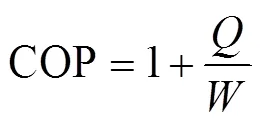
式中COP为海水源热泵的制热性能系数,无量纲;为海水源热泵单位质量工质的制热量,kW/kg;为海水源热泵单位质量工质压缩机所消耗的电能,kW/kg。
1.3.2 热能回收率计算
Ⅰ级换热器或海水源热泵对育苗废水热能的回收率可由下式计算
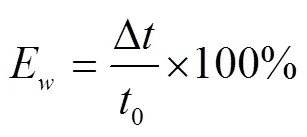
式中w为育苗废水的热能回收率,%;0为Ⅰ级换热器或海水源热泵中育苗废水的入流温度,℃;Δ为Ⅰ级换热器或海水源热泵中育苗废水进、出水温差,℃。
2 结果与分析
2.1 Ⅰ级换热器运行效果
系统运行期间,Ⅰ级换热器中育苗废水和新鲜海水的温度变化如图2所示。由图2看出,进入Ⅰ级换热器的育苗废水与新鲜海水的温差越大,新鲜海水升温效果越好。当育苗废水和新鲜海水的入流温度分别为10.3和−1.9 ℃(温差为12.2 ℃)时,新鲜海水和育苗废水的出口温度分别为3.9和4.2 ℃,新鲜海水的温升幅度和育苗废水温降幅度分别达到5.8和6.1 ℃;当育苗废水和新鲜海水的入流温度分别为14.9和4.9 ℃(温差为10.0 ℃)时,新鲜海水和育苗废水的出口温度分别为9.5和10.0 ℃,新鲜海水的温升幅度和育苗废水温降幅度分别为4.6和4.9 ℃。另由图2发现,2014年12月至次年3月期间,Ⅰ级换热器中育苗废水的入流温度在10.3~13.0 ℃之间波动,比育苗车间排放的废水温度(15 ℃)平均低3.4 ℃,由于废水蓄水池未进行保温隔热处理,因而造成一定的热量散失。不过在运行工况条件下,Ⅰ级换热器对新鲜海水的升温幅度仍保持在4.6~5.8 ℃,育苗废水热能的最大回收率达到59.2%。
2.2 海水源热泵设备运行效果
废水热源的温度为14.5 ℃、流量为20 m3/h时,不同新鲜海水温度和流量工况下,海水源热泵中新鲜海水和育苗废水的温度变化以及热泵的制热性能系数分别见图3和图4。
图3结果显示,当海水源热泵中废水热源的温度和流量一定时,新鲜海水的温升幅度与其入流温度和流量成反比。例如,当进入冷凝器的新鲜海水温度为7.3 ℃,流量由10增至20 m3/h时,新鲜海水的出水温度分别为18.6和13.2 ℃,其温升幅度由11.3降至5.9 ℃;当冷凝器中入流新鲜海水的温度为10.3 ℃时,在对应流量条件下,新鲜海水的出水温度分别为20.1和16.6 ℃,新鲜海水的温升幅度由9.8降至6.3 ℃。在运行工况条件下,育苗废水的温降幅度为5.7~6.0 ℃。分析原因,当进入海水源热泵的育苗废水的温度和流量一定时,单位时间内被蒸发器中的工质提取的总热量相对稳定,因而育苗废水的温降幅度变化不大;同时,在系统换热量一定的条件下,当新鲜海水的流量增加时,其换热温差减小[28-29],因此冷凝器出水的温升幅度降低;另外,当进入冷凝器的新鲜海水的温度升高时,冷凝温度随之升高[29-30],致使新鲜海水的温升幅度减小。由图3还可看出,当进入冷凝器的新鲜海水温度为7.3 ℃,流量不超过15 m3/h时,新鲜海水的出水温度保持在15.1~18.6 ℃,当新鲜海水的入流温度为10.3 ℃,流量达到20 m3/h时,冷凝器出水的温度为16.6 ℃,均可满足海参育苗水温(15 ℃)要求。系统运行期间,海水源热泵设备对育苗废水热能的最大回收率达到40.7%。
由图4可知,当废水热源的温度和流量保持不变时,海水源热泵的制热性能随新鲜海水的入流流量增加而增加,随新鲜海水的入流温度升高而降低。在运行工况条件下,当冷凝器中入流新鲜海水的温度为7.3 ℃,流量由10增至20 m3/h时,海水源热泵设备的COP由5.28增至5.52;当进入冷凝器的新鲜海水的温度升至10.3 ℃,在对应流量条件下,海水源热泵设备的COP由5.03增至5.40。主要是因为随着新鲜海水的流量增加,冷凝器中流体的雷诺数增大,努谢尔数随之增加[26],单位时间内新鲜海水获取的总热量增加[29-30],因此热泵设备的COP随之增加;另一方面,当冷凝器中新鲜海水的入流温度升高时,冷凝温差减小,压缩机的功耗增加,致使热泵设备的COP降低[29-30]。在运行工况条件下,当冷凝器中新鲜海水的入流流量保持在15 m3/h以上时,海水源热泵设备具有较佳的制热性能。
2.3 节能减排效果核算
2.3.1 计算依据
该企业每天升温新鲜海水5 000 m3,升温期为每年11月中旬至次年4月中旬,年升温天数按150 d计。根据该企业所处的地理位置,水体升温期按寒冷期(新鲜海水温度低于0 ℃)为60 d、常规期(新鲜海水温度0~5 ℃)为90 d计算。本文分别按集成升温(海水源热泵机组+锅炉)和传统升温(锅炉升温)核算相关节能减排指标。
集成升温系统中Ⅰ级换热器运行流量为400 m3/h,每天运行12.5 h,配套4台功率分别为18.5 kW的循环水泵;海水源热泵设备的额定功率为30 kW、制热量为130 kW,配套1.8 kW的废水泵和新鲜海水泵各1台,每天升温新鲜海水400 m3;锅炉设备的运行流量为400 m3/h,每天运行11.5 h,2台循环水泵的功率分别为18.5 kW,鼓风机、引风机和上煤机构等辅助设备的功率共计160 kW。
传统升温锅炉的运行流量为400 m3/h,升温期间,每天运行12.5 h,直接将新鲜海水(−1.9~5.0 ℃)升温至15 ℃,其他配套设备同上。
其他参数:海水定压比热取4.096 kJ/(kg·℃)、密度取1 021.54 kg/m3;企业采购的煤炭燃烧值为22 990 kJ/kg、价格为800元/t、锅炉热效率为65%,用电电价为0.9元/(kW×h),1 t标煤二氧化碳排量按2.4 t计算[13]。
2.3.2 升温能耗与能源费用核算
升温期间,海水源热泵机组的电能消耗量和锅炉设备的煤炭消耗量分别按公式(3)和(4)计算[28]

(4)
式中1、2分别为海水源热泵机组和锅炉升温所需的总热量,kJ/a;COP为海水源热泵的制热性能系数,无量纲;W为海水源热泵机组每年消耗的电能,(kW·h)/a;W为锅炉设备每年消耗的煤炭量,kg/a;为煤炭的燃烧值,取22 990 kJ/kg(企业提供数据);η为锅炉设备的热效率,取65%(企业提供数据)。
2.3.3 设备投资回收期计算
海水源热泵机组设备投资回收期按公式(5)计算[28]
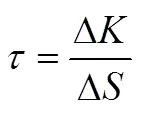
式中为投资回收期,a;Δ为海水源热泵机组增加的投资额,本期投资60万元;Δ为海水源热泵设备每年节约能源费用,万元/a。
Δ=1−2(6)
1=0.8W1×10-4
2=(0.9W+0.8W2)×10-4
式中1为传统锅炉升温每年消耗的能源费用,万元/a;2为集成升温每年消耗的能源费用,万元/a;W为海水源热泵机组每年消耗的电能,(kW×h)/a;W1为传统升温锅炉设备每年消耗的煤炭量,kg/a;W2为集成升温锅炉设备每年消耗的煤炭量,kg/a。
海参育苗水体集成升温与传统锅炉升温工况下,主要节能减排指标的核算结果见表1。
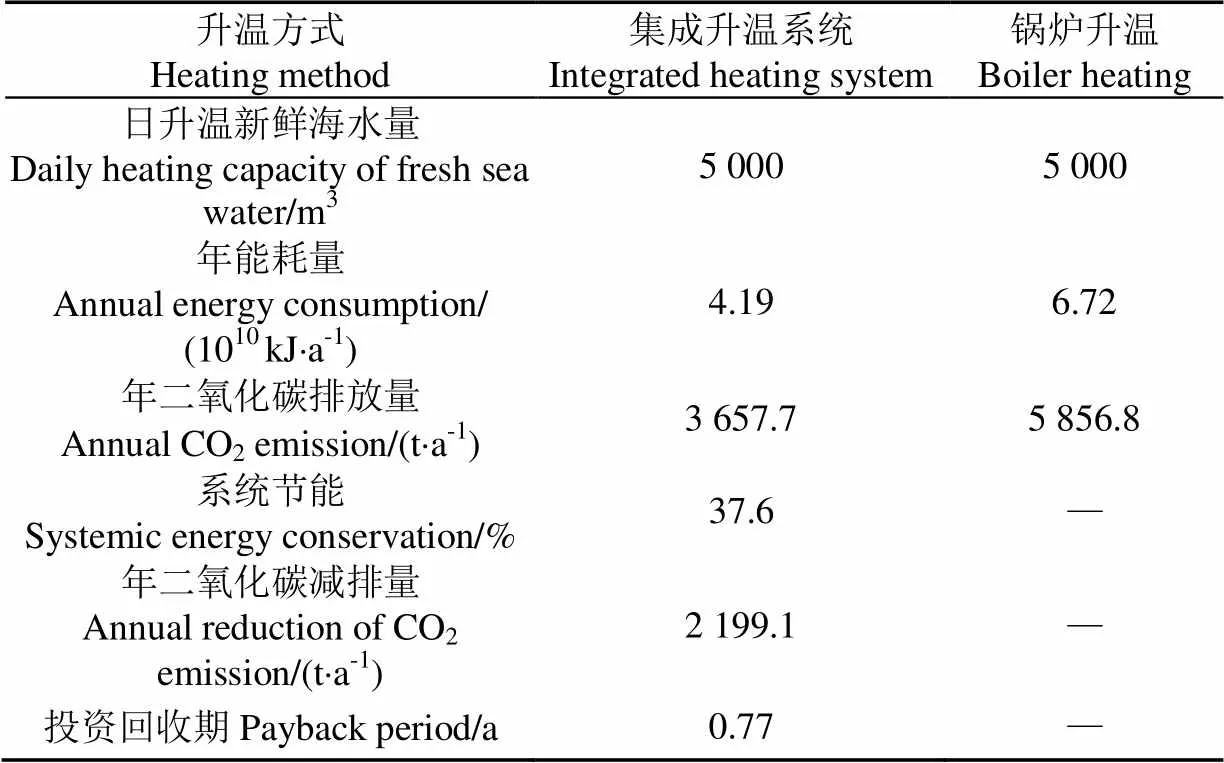
表1 不同升温方式的能耗与温室气体排放量
由表1看出,每日升温新鲜海水5 000 m3时,集成升温和传统锅炉升温系统的能耗量分别为4.19×1010和6.72×1010kJ/a,二氧化碳排放量分别为3 657.7和5 856.8 t/a,集成升温系统比传统锅炉升温综合节能37.6%以上,减排二氧化碳约2 200 t/a,而且当年即可收回海水源热泵机组设备的投资费用,可见海水源热泵机组取得了比较显著节能减排效果。
3 结 论
本文针对水产生物工厂化育苗水体升温技术需求,设计完成了由Ⅰ级换热器与海水源热泵设备组成水体升温和废水热能回收系统,并应用于海参工厂化育苗生产中,系统运行结果表明
1)Ⅰ级换热器的换热效率与育苗废水和新鲜海水的温差成正比,利用温度为10.3~14.9 ℃的海参育苗废水,可将−1.9~4.9 ℃的新鲜海水提升至3.9~9.5 ℃,新鲜海水的最大温升幅度为5.8 ℃,育苗废水的温降幅度达到4.9~6.1 ℃,废水热能的最大回收率达到59.2%。
2)当育苗废水温度和流量一定时,海水源热泵设备对新鲜海水的升温幅度随其入流流量和温度升高而降低。入流温度分别为7.3和10.3 ℃的新鲜海水,流量由10提高到20 m3/h时,温升幅度分别由11.3和9.8 ℃降至5.9和6.3 ℃;当新鲜海水的流量分别为15和20 m³/h时,海水源热泵设备可将其温度提升至15 ℃以上,满足海参育苗生产需要;另外,在运行工况条件下,海水源热泵设备具有良好的制热性能,系统COP一直保持在5.03以上;升温期间,育苗废水的温降幅度为5.7~6.0 ℃,热能最大回收率达到40.7%。
3)与传统锅炉升温相比,集成升温系统综合节能37.6%以上,每年减排二氧化碳约2 200 t,而且当年可回收设备投资,海水源热泵机组用于育苗水体升温和废水热能回收,具有比较明显的节能减排方面优势。
[1] 农业部渔业渔政管理局. 2016年中国渔业统计年鉴[M]. 北京:中国农业出版社,2016:64.
[2] 勾维民,刘佳丽. 大连水产苗种产业现状及发展对策[J].黑龙江水产,2012(2):36-38.
Gou Weimin, Liu Jiali. Developing strategy of aquatic animal nurse ring industries[J]. Heilongjiang Fisheries, 2012(2): 36-38. (in Chinese with English abstract)
[3] 王如才,王昭萍. 海水贝类养殖学[M]. 青岛:中国海洋大学出版社,2008:155-203.
[4] 金书秦,陈洁. 我国水产养殖的直接能耗及碳排放研究[J].中国渔业经济,2012,30(1):73-82.
Jin Shuqin, Chen Jie. A study on energy consumption and carbon emission of China’s aquaculture[J]. Chinese Fisheries Economics, 2012, 30(1): 73-82. (in Chinese with English abstract)
[5] 车轩,刘晃,吴娟,等. 我国主要水产养殖模式能耗调查研究[J]. 渔业现代化,2010,37(2):9-13.
Che Xuan, Liu Huang, Wu Juan, et al. Investigation into energy consumption of aquaculture in China[J]. Fishery Modernization, 2010, 37(2): 9-13. (in Chinese with English abstract)
[6] 赵鹏,李贤,周兴,等. 海水工厂化养殖能耗及新能源应用调研分析[J]. 渔业现代化,2011,38(2):21-25.
Zhao Peng, Li Xian, Zhou Xing, et al. Study on energy consumption and new energy applications in industrial marinculture[J]. Fishery Modernization, 2011, 38(2): 21-25. (in Chinese with English abstract)
[7] 王晓春. 我国水产养殖节能减排问题分析[J]. 农业经济与管理,2012(6):87-91.
Wang Xiaochun. Analysis on aquaculture energy saving and emission reduction of China[J]. Fisheries Economy Research, 2012(6): 87-91. (in Chinese with English abstract)
[8] 刘鹰,刘宝良. 我国海水工业化养殖面临的机遇和挑战[J].渔业现代化,2012,39(6):1-4.
Liu Ying, Liu Baoliang. Opportunities and challenges for marine industrialized aquaculture in China[J]. Fishery Modernization, 2012, 39(6): 1-4. (in Chinese with English abstract)
[9] Badiola M, Mendiola D, Bostock J. Recirculating aquaculture systems (RAS) analysis: Main issues on management and future challenges[J]. Aquacultural Engineering, 2012(51): 26-35.
[10] 胡松涛,陈茂科,郭潇潇. 海水源热泵与传统空调系统能耗比较分析[J]. 青岛理工大学学报,2008,29(2):2-5.
Hu Songtao, Chen Maoke, Guo Xiaoxiao. Energy source consumption analysis and comparison between ocean heat pump and traditional air conditioning system[J]. Journal of Qingdao University of Technology.2008, 29(2): 2-5. (in Chinese with English abstract)
[11] Chua K J, Chou S K, Yang W M. Advances in heat pump systems: A review[J]. Applied Energy, 2010, 87(12): 3611-3624.
[12] 刘建禹,李文涛,陈泽兴,等. 基于地下水源热泵的寒区沼气工程加热模式的探讨[J]. 农业工程学报,2013,29(5):163-169.
Liu Jianyu, Li Wentao, Chen Zexing, et al. Heating mode of biogas plant in alpine region based on underground water source heat pump[J]. Transactions of the Chinese Society of Agricultural Engineering (Transactions of the CSAE), 2013, 29(5): 163-169. (in Chinese with English abstract)
[13] Izquierdo M, de Agustín P, Martin E. A micro photovoltaic- heat pump system for house heating by radiant floor: Some experimental results[J]. Energy Procedia, 2014, 48: 865-875.
[14] 柴立龙,马承伟,张义,等. 北京地区温室地源热泵供暖能耗及经济分析[J]. 农业工程学报,2010,26(3):249-254.
Chai Lilong, Ma Chengwei, Zhang Yi, et al. Energy consumption and economic analysis of ground source heat pump used in greenhouse in Beijing[J]. Transactions of the Chinese Society of Agricultural Engineering (Transactions of the CSAE), 2010, 26(3): 249-254. (in Chinese with English abstract)
[15] 孙维拓,杨其长,方慧,等. 主动蓄放热-热泵联合加温系统在日光温室的应用[J]. 农业工程学报,2013,29(19):168-173.
Sun Weituo, Yang Qichang, Fang Hui, et al. Application of heating system with active heat storage-release and heat pump in solar greenhouse[J]. Transactions of the Chinese Society of Agricultural Engineering (Transactions of the CSAE), 2013, 29(19): 168-177. (in Chinese with English abstract)
[16] 龚希武,张艳. 海水热泵系统设计及技术经济分析[J]. 节能技术,2013,31(1):54-56.
Gong Xiwu, Zhang Yan. A seawater heat pump air conditioning system design and economic analysis[J]. Energy Conservation Technology, 2013, 31(1): 54-56. (in Chinese with English abstract)
[17] 张莉,胡松涛. 海水作为热泵系统冷热源的研究[J]. 建筑热能通风空调,2006,25(3):34-38.
Zhang Li, Hu Songtao. Research on the heat pump system using seawater as heat source or sink[J]. Building Energy & Environment, 2006, 25(3): 34-38. (in Chinese with English abstract)
[18] 倪龙,唐青松,李安民,等. 带辅助热源的地源热泵设计负荷比分析[J]. 制冷学报,2010,31(5):18-23.
Ni Long, Tang Qingsong, Li Anmin, et al. Analysis on design heating load ratio of ground source heat pump with auxiliary heat source[J]. Journal of Refrigeration, 2010, 31(5): 18-23. (in Chinese with English abstract)
[19] Baik Y, Kim M, Chang K, et al. Potential to enhance performance of seawater-source heat pump by series operation[J]. Renewable Energy, 2014, 65: 236-244.
[20] Odd-Ivar L. Aquaculture engineering[M]. Blackwell Publishing Ltd. UK, 2007: 121-129
[21] 王际英,李宝山,宋志东. 地源热泵技术在海水工厂化养殖系统中的应用[J]. 渔业现代化,2011,38(1):12-18.
Wang Jiying,Li Baoshan,Song Zhidong. Utilization of geothermal heat pump technique in marine industrial culture system[J]. Fishery Modernization, 2011, 38(1): 12-18. (in Chinese with English abstract)
[22] 郑荣进,孙文君,张建高,等. 基于可再生能源供热的设施水产养殖试验温室设计[J]. 农业工程学报,2011,27(10):218-221.
Zheng Rongjin , Sun Wenjun, Zhang Jiangao, et al. Field test building design for controlled aquaculture based on renewable energy heating system[J]. Transactions of the ChineseSociety of Agricultural Engineering (Transactions of theCSAE), 2011, 27(10): 218-221. (in Chinese with English abstract)
[23] 刘国丹,刘珂珂,胡松涛,等. 海参养殖热泵系统应用探讨[J]. 暖通空调,2014,9(44):56-61.
Liu Guodan, Liu Keke, Hu Songtao, et al. Application of heat pump system for sea cucumber aquacultur[J]. HV&AC, 2014, 9(44): 56-61. (in Chinese with English abstract)
[24] Oh J T, Oh H K. Development of high efficient heat pump system using the heat source of exhaust water[C]// Proceedings of the 7th International Energy Agency Conference on Heat Pumping Technologies, Beijing, China, 2002: 732-743.
[25] Okamoto S. A heat pump system with a latent heat storage utilizing seawater installed I an aquarium[J].Energy and Building, 2006, 38(2): 121-128.
[26] 李秀辰,母刚,张国琛,等. 海水源热泵在养殖水体升温与废水余热回收中的应用效果[J]. 农业工程学报,2014,30(3):142-148.
Li Xiuchen, Mu Gang, Zhang Guochen, et al. Application effect of seawater source heat pump for water heating and waste heat recovery in flatfish culture system[J]. Transactions of the Chinese Society of Agricultural Engineering(Transactions of the CSAE), 2014, 30(3): 142-148. (in Chinese with English abstract)
[27] 李秀辰,吴丽娜,张国琛,等. 以育苗废水作热源的海水热泵制热性能研究[J]. 大连海洋大学学报,2012,27(3):279-283.
Li Xiuchen, Wu Li′na, Zhang Guochen, et al. A seawater heating pump using effluent from a hatchery for heat recovery in a recirculating aquaculture system[J]. Journal of Dalian Ocean University, 2012, 27(3): 279-283. (in Chinese with English abstract)
[28] 马最良,姚杨,姜益强,等. 暖通空调热泵技术[M]. 北京:中国建筑工业出版社,2008:88-91.
[29] 孙天宇,王庆阳,张健,等. 水温水量对水源热泵制热性能的影响[J]. 热力发电,2014,43(10):8-11.
Sun Tianyu, Wang Qingyang, Zhang Jian, et al. Effect of water temperature and flow on heating performance of water source heat pumps[J]. Thermal Power Genergration, 2014, 43(10): 8-11. (in Chinese with English abstract)
[30] 陈则韶,江斌,史敏. 影响热泵COP 的因素与节能途径分析[J]. 流体机械,2007,35(1):64-67.
Chen Zeshao, Jiang Bin, Shi Min. Analysis of Factors Influencing the COP of Heatpump and Energysaving methods[J]. Fluid Machinery, 2007, 35(1): 64-67. (in Chinese with English abstract)
Engineering application of seawater-source heat pump for waste heat recovery in sea cucumber breeding system
Li Xiuchen1, Deng Wei1, Zhang Dianguang1, Mu Gang1, Zhang Guochen1, Chen Shuai1, Che Quan2
(1.116023,; 2.,116222,)
In order to cut down energy consumption, heat loss and air pollution for water heating in indoor aquaculture system, a seawater-source heat pump system, which comprised 2 heat exchangers (namely I-stage exchangers) and a seawater-source heat pump and employed waste water as heating source, was developed and applied in an aquatic organism indoor nursing system. The onsite flow rate of waste water and fresh seawater in I-stage exchangers were regulated to 400 m3/h, respectively. The flow rate of waste water in the seawater-source heat pump was 20 m3/h, while the flow rate of fresh seawater increased from 10 to 20 m3/h during the onsite operation. The effectiveness for fresh seawater heating and the heat recovery of waste water by the seawater-source heat pump system were studied on site, and the amounts of energy consumption and carbon emission during the heating period were correspondingly calculated and compared with conditional coal-fired boiler heating approach. It showed that the heat-exchanging efficiency of I-stage heat exchangers was in direct proportion to the temperature difference of inflowing waste water and fresh seawater. When the inlet temperatures of waste water and fresh seawater were 10.3 and -1.9 ℃, respectively, the 5.8 ℃ increment of temperature in fresh seawater and 6.1 ℃ drop of temperature in waste water were observed. Additionally, with 14.9 ℃ inflowing waste water and 4.9 ℃ fresh seawater, the outlet temperature of fresh seawater increased to 9.5 ℃, while the waste water dropped to 10.0 ℃. The maximum heat recovery efficiency by I-stage exchangers from waste water was 59.5%. On the other hand, when the temperature and flow rate of inflowing waste water were not changed, the temperature increment of fresh seawater from the seawater-source heat pump was inversely proportional to its inflowing rate and temperature. With waste water of 14.9 ℃ as the heat source of the seawater-source heat pump, the temperature of fresh seawater increased from 7.3 to 18.6 ℃ at 10 m3/h and to 13.2 ℃ at 20 m3/h, which brought out temperature increment of 5.9-11.3 ℃. In the same case, the temperature of fresh seawater out of the seawater-source heat pump increased from 10.3 to 20.1 ℃ at 10 m3/h and to 16.6 ℃ at 20 m3/h, with temperature increment of 6.3-9.8 ℃. Accordingly, when the temperature of inflowing fresh seawater was 7.3 and 10.3 ℃, appropriate water temperature (15 ℃) could be obtained for aquatic organism indoor nursing by keeping the flow rate of fresh seawater at 15 and 20 m3/h, respectively. It was also found that the temperature drop of waste water in the seawater-source heat pump was about 6 ℃ during the operation, which gained the heat recovery efficiency of 40.7% for waste water. The coefficient of performance (COP) of the seawater-source heat pump was 5.03-5.52. In comparison with traditional coal-fired boiler heating approach, the integrated seawater-source heat pump system demonstrated significant drop in energy consumption (over 37.6%) and carbon dioxide emission (about 2 200 t/a). The payback period for the seawater-source heat pump system would be about 0.77 a. Therefore the seawater-source heat pump system has an obvious potential in energy conservation and carbon emission reduction in indoor aquaculture system.
waste water; heating; temperature; sea cucumber; water heating; seawater-source heat pump; heat recovery
10.11975/j.issn.1002-6819.2017.09.028
TKS
A
1002-6819(2017)-09-0218-06
2016-12-11
2017-04-12
辽宁省科学技术重点项目(2008228001);大连市科技兴海专项资金项目(20140301)
李秀辰,女,博士,教授,主要从事渔业装备与节能减排技术研究。大连 大连海洋大学辽宁省渔业装备工程技术研究中心,116023。 Email:lxc@dlou.edu.cn
李秀辰,邓 伟,张殿光,母 刚,张国琛,陈 帅,车 全. 海水源热泵对海参育苗废水热能回收的工程应用[J]. 农业工程学报,2017,33(9):218-223. doi:10.11975/j.issn.1002-6819.2017.09.028 http://www.tcsae.org
Li Xiuchen, Deng Wei, Zhang Dianguang, Mu Gang, Zhang Guochen, Chen Shuai, Che Quan. Engineering application of seawater-source heat pump for waste heat recovery in sea cucumber breeding system[J]. Transactions of the Chinese Society of Agricultural Engineering (Transactions of the CSAE), 2017, 33(9): 218-223. (in Chinese with English abstract) doi:10.11975/j.issn.1002-6819.2017.09.028 http://www.tcsae.org
